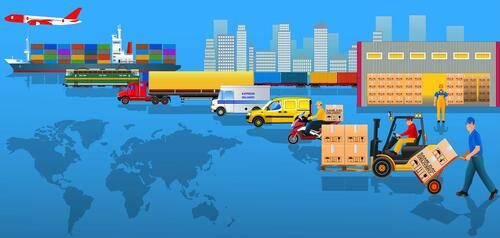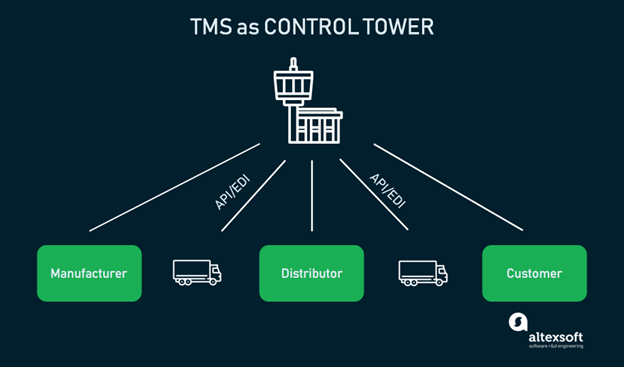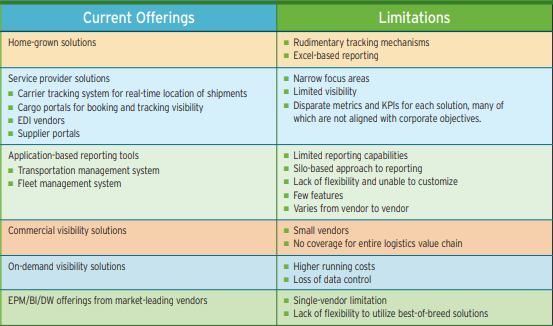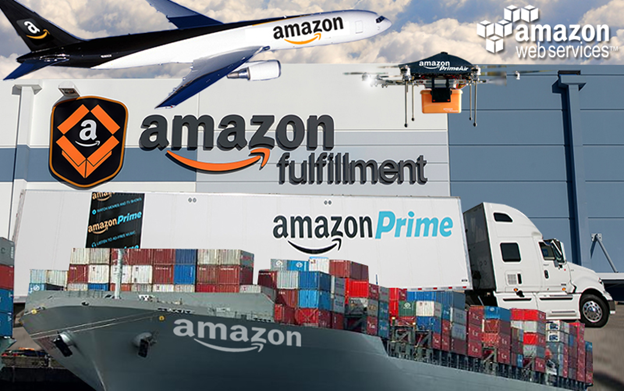TRAN1060 Passenger and Freight Transport Assignment Sample
Historical perspective
In order to establish a compact, quick and convenient customer service representative supply chain, producers, retailers, as well as 3rd-party logistics companies have focused on freight and logistics management. Sustaining the fine stability of higher resource and shipping expenses itself against demands of enhanced provider standards imposed by consumers is one of the most difficult difficulties such sectors confront nowadays. Many industry participants are working together with their main vendors as well as customers to enhance their procedures and methods in order to enhance service excellence, cheaper prices, and increase transparency. Developing an effective & efficient supply chain intelligence network is critical to maximizing the benefits of these kinds of positions to ensure (Oršič et al.2018). Corporations are actively leveraging the devices that can connect systems integration and technical advancements in track-and-trace, effective control mechanisms, as well as IT advancements for instance, cloud platforms to provide enhanced consumer experience at lower expenses. Companies would also be required to reorient their logistics effectiveness assessment techniques to fully know the advantages of these projects and proceed forward with a period of continual quality innovation in their business. Efficiency administration is a mechanism for ensuring that a company’s policy is carried out as efficiently as possible. It comprises a series of interconnected, closed-loop data analyses that tackle both operational and financial data and are backed by advanced technologies. It allows a company to establish, analyze, as well as monitor its progress in relation to tactical objectives. Enterprise performance management (EPM), or business performance management (BPM), or Corporate performance management (CPM), are more acronyms for quality management. However, in order to phrase it another way, it’s a deliberate attitude to boosting operational efficiency. [Referred to Appendix 2]
Current Situation
Truck service, for particular, saw little shrinkage throughout the 1980s, 1982s, and 1991s times of recession. In comparison, the business declined by 6% in 2001, while the 2008 recession caused an 18% reduction. Sector numbers, like those in any other industry, do not reveal the complete story.

Figure 1: Implementation of transportation in logistics
(Source: https://www.cleo.net)
A TMS has always been a solution that may improve organizational performance, increase income, and provide better customer service for any logistics firm. There are several benefits to adopting a TMS to assist firms in reliably and accurately transporting freight between source to recipient. Consider its scheme’s effectiveness and how it may assist the firm before settling on a TMS. Amongst some of the benefits of a TMS seem to be the following:
Real-time delivery tracking – A TMS enables businesses to monitor where their drivers and cargo were at that given moment (Sternad, 2018). It also provides information on just how lengthy a trip takes, which may be utilized to create a more efficient travel schedule. It also gives recommendations for the best drivers and paths.
Minimize freight costs- The decrease of transportation charges is amongst the most important benefits of either a TMS. This technique is expected to save cost by combining analytics and usage. The logistics company generates cost-cutting suggestions and uses statistics to provide useful insights.
Enhance warehouse effectiveness & repository- Given the constant flow of coming and exciting items, another well warehouse appears to be an essential part of the transportation chain. When a TMS and just a WMS are integrated, it is feasible to maintain track of orders once they’re in the warehousing, throughout transit, and so when finally arrive. Customers should be able to evaluate operations and confirm that they were fruitful as a consequence of anything like this.
Enhanced customer levels- Increase customer service with the capability to track on-time execution are two benefits of a TMS (Gruchmann et al.2020). Furthermore, the opportunity to trace the exact position of deliveries and how far things seem to be from their end location has been generated. The TMS furthermore includes an online portal where suppliers may check their delivery and alert their customers. Customers may now access delivery and freight information anytime they need to use it, which improves service to the consumer.
Improve supply chain effectiveness- The researcher recorded drivers, products, and other operations that can assist the organization and be much more effective. This might also assist to improve the supply chain and reduce waste. Consumers will benefit from the responsive supply chain since it not only increases productivity and profitability but then also saves a lot of money.

Figure 2: Implementation of TMS
(Source: https://www.altexsoft.net/)
According to a 2008 survey which was organized by InformationWeek, 91percent of the total of logistics and transport organizations used BI technologies substantially. Merely 46percent of companies, on the other hand, intended to give greater business intelligence to even more people, faster during that time. It’s clear that there’s a disconnect among distribution and reaping the rewards (M’hand et al.2019). Some of the personnel currently rely on out-of-date lasting legacy apps or/and Excel-based data tracking. In order t o generate insights as well as prepare reports, many autonomous programmes like those of OMS, TMS, WMS, and others are employed. Logistics coordinators do not even possess a clear image of the formerly the logistics chain due to which as a result of all these limitations, even though they are unable to standardize findings for comparability and distribution. Furthermore, third-party suppliers as well as other operational providers give evidence in their very own forms, resulting in bottlenecks and lost efficiency in the company’s consolidation and assimilation of data.

Figure 3: Implementation of
(Source: https://www.cognizant.net)
Problems and Solutions
Transportation as well as logistics seems to be under relentless stress in emerging consumer-based, digitized culture in order to stay marketable, offer efficient customer service, as well as develop revolutionary procedures to optimize their processes. In this essay, there will be discussion regarding the need that people will have to go through company’s current issues, and even the innovative innovations that can assist in solving them and, in turn, enhance the supply chain benefiting companies heading ahead.
Offering Segmented & Customer Service
Supply chain depends upon the capacity of segregating and customizing innovation to share an unified platform of data throughout a network of organizations. Data exchange throughout the supply chain permits for greater visibility within logistics, enabling customers in order to make informed decisions regarding the items they purchase and establishing a mutual trust among the firm as well as the customer.
Even when it switches hands amongst the maker, distributor, and user, block chain can also be employed to track a package’s life cycle including copyright transference from source to retailer shelves (Knop, 2019). Across a readily transportable monitoring system, blockchain additionally enables the supply chain sector to migrate wherever inventory as well as other company necessities is across the organization. Businesses have begun to integrate blockchain innovation into existing shopping websites, letting consumers recognize their product’s location and intended delivery schedule the moment they make their transaction.
Cutting Transportation Costs
Freight rates can make up a significant amount of a service provider’s total logistical costs. Whenever the price of gas rises, users shoulder the economic strain by consenting to invest more on commuting (Radović et al.2018). Companies have improved their methods for resolving such issues, which will facilitate the detection of transit issues and the implementation of viable alternatives.
To track prospective actual information with itineraries along with possible alternative pathways to save shipping expenditures, the logistics sector has begun to include automated monitoring as well as artificial intelligence through its trucks (Periokaitė and Dobrovolskienė, 2021). Corporations might employ sensors in order to develop a smart car which can enhance gas mileage, assess traffic conditions, and monitor the ways the human driver reacts throughout pathways using Autonomous Tracker. FedEx, for example, has begun to integrate automated tracking equipment into their daily logistics, collecting information from cars and crews to operate pathways that are more efficient.
Tracking, Management & Inventory Visibility
Because many businesses rely on inventory, the most crucial talent for freight as well as logistics specialists is the ability to assess and manage merchandise properly. If a corporation never has precise, legitimate stock levels at a specific location, it could put a strain on sales and/or detract from a positive customer experience. Furthermore, supply chains must routinely track and manage inventory across several warehouses, merchants, or locations, which can be a difficult task if the infrastructure and services are not really linked (Zhang and Peng, 2020).
To address such difficulties, freight as well as logistics organizations are engaging in complete cloud-based solutions, like inventory management systems and transportation administration systems that provide real-time insights that help operations regardless of location or schedule. Probabilistic modeling, which employs computers to optimize and produce sophisticated supply chain predictions based on both domestic as well as global statistics, is also being used by businesses. Forecasting statistics are presently being employed by companies such as Apple, Whole Foods, and Amazon may use them in the future to provide proactive shipping. [Referred to Appendix 1]
Manpower Management
Since this Freight as well as Logistics organization grows, the need for a faster, smarter, and more organized personnel approach for monitoring all entering and departing merchandise has become crucial. Mostly across the T&L industry, the need for faster and more efficient transportation strategies has been a worry for many businesses as a consequence of rising marketplaces like amazon.
As a consequence, the logistics industry has merged robotic and drone technology into warehouses, allowing it to generate an infinite number of workers without encountering additional costs (Gebresenbet et al.2018). Computerized labor equipment will indeed speed up the classification of arrivals and departures connectivity consignments, as well as the positioning of delivery on appropriate shelves or shipping boats as well as the examination of items for defects ahead to departure. Retailers like Amazon already have begun to employ robotic drone innovation within their daily operations, reducing shipment times while saving money.
Recommendations
Some of the recommendations for monitoring the transportation for enhancing Company’s logistics have been listed here below as follows:
Analytics
While large transit companies have begun to incorporate all of this, there are just not enough current alternatives that elegantly integrate all of the necessary features. The ability to govern all components through an interface opens up the possibilities of improved analytics & preemptive approaches, in addition to facilitating operating procedures. Technological solutions that keep track of all the specifics of successful and unsuccessful deliveries provide accurate figures plus real-time deep perspective (Bubnova et al.2018). Logistics businesses will be able to handle issues as well as avoid those with the use of appropriate digital technologies. Organizations who adopt this reasoning and create customized applications to handle their deliveries at all levels will ultimately supplant others who are unable to keep awake.
Vehicle & Inventory Maintenance
Logistics businesses must verify the functioning of their trucks on a regular basis to avoid going out of trade. They may combine fleet management technologies to accelerate the operation. There have been tools like Fleetio that make monitoring and reporting simple.
Map and Navigation
A navigation-enabled smartphone app must significantly reduce transit costs. These apps provide the highest possible speed and efficiency of service by avoiding interruptions, detecting difficulty areas, and determining the optimum pathways in a specific circumstance (Martins et al.2020). The integration of stakeholders in the business is a crucial consideration. It must be efficient for both exporters and transporters, and end users must be pleased with the outcome. Every participant in the procedure must get their separate copy of the application.
Labor Management
Several time-consuming laborious tasks can be reduced by using smartphone applications, such as permitting documentation interchange or giving a record for transporters including warehouse personnel. They no longer have to physically sign themselves out of a chore when a computerized programme can do it for them.
Assessment of the Solutions
In a word, each logistics program should have a configurable roadmap & guidance feature, as well as path optimization and traffic data. The more linkages in the network, the more urgent the problem becomes. With the help of all-in-one smartphone applications may simplify transit management and increase delivery pace, which are both key concerns for logistics organizations today (Dubolazov et al.2019).
It’s difficult to manage freight operations without a technology for allocating tasks and tracking actions because there are so many individuals taking part. Labor – management technologies were developed to decrease error rates, minimize documentation, and improve overall efficiency. Businesses can simply manage the accessibility of staff and machinery, track transportation whereabouts, even check on activities within the warehouses by employing a good smartphone application (Restuputri et al.2020).
Logistics providers may save a lot of money on transportation by using software. Using optimal routing, one can save a lot of money by lowering the no. of kilometers traveled and hence the amount of gasoline consumed. In addition, smart path optimization software allows transportation planners to consider & minimize toll pathways.
Reference List
Journal
Gruchmann, T., Pratt, N., Eiten, J. and Melkonyan, A., 2020. 4PL digital business models in sea freight logistics: The case of Freighthub. Logistics, 4(2), p.10.
Sternad, M., 2018. Metrics of logistics costs in Slovenian companies. Business Logistics in Modern Management.
Oršič, J., Rosi, B. and Jereb, B., 2019. Measuring sustainable performance among logistic service providers in supply chains. Tehnički vjesnik, 26(5), pp.1478-1485.
M’hand, M.A., Boulmakoul, A., Badir, H. and Lbath, A., 2019. A scalable real-time tracking and monitoring architecture for logistics and transport in RoRo terminals. Procedia Computer Science, 151, pp.218-225.
Knop, K., 2019. Evaluation of quality of services provided by transport & logistics operator from pharmaceutical industry for improvement purposes. Transportation Research Procedia, 40, pp.1080-1087.
Radović, D., Stević, Ž., Pamučar, D., Zavadskas, E.K., Badi, I., Antuchevičiene, J. and Turskis, Z., 2018. Measuring performance in transportation companies in developing countries: a novel rough ARAS model. Symmetry, 10(10), p.434.
Periokaitė, P. and Dobrovolskienė, N., 2021. The impact of COVID-19 on the financial performance: a case study of the Lithuanian transport sector. Insights into Regional Development, 3(4), pp.34-50.
Zhang, G., Li, G. and Peng, J., 2020. Risk Assessment and Monitoring of Green Logistics for Fresh Produce Based on a Support Vector Machine. Sustainability, 12(18), p.7569.
Gebresenbet, G., Bosona, T., Olsson, S.O. and Garcia, D., 2018. Smart system for the optimization of logistics performance of the pruning biomass value chain. Applied Sciences, 8(7), p.1162.
Bubnova, G.V., Efimova, O.V., Karapetyants, I.V. and Kurenkov, P.V., 2018. Information technologies for risk management of transportation–logistics branch of the “Russian Railways”. In MATEC Web of Conferences (Vol. 235, p. 00034). EDP Sciences.
Martins, R., Pereira, M.T., Ferreira, L.P., Sá, J.C. and Silva, F.J.G., 2020. Warehouse operations logistics improvement in a cork stopper factory. Procedia Manufacturing, 51, pp.1723-1729.
Dubolazov, V.A., Shchelkonogov, A.A. and Temirgaliev, E.R., 2019, September. Use of Internet of things to assess KPI in the transport logistics service. In International Conference on Digital Technologies in Logistics and Infrastructure (ICDTLI 2019) (pp. 275-279). Atlantis Press.
Restuputri, D.P., Masudin, I. and Sari, C.P., 2020. Customers perception on logistics service quality using Kansei engineering: Empirical evidence from indonesian logistics providers. Cogent Business & Management, 7(1), p.1751021.
Hafizan, F.R.M., THE DEVELOPMENT OF HALAL LOGISTICS WAREHOUSE: A STUDY AT MASKARGO SDN BHD.
Karrieva, Y., 2020. Strategy of functioning of logistics companies in Uzbekistan. Архив научных исследований.
Jagtap, S., Bader, F., Garcia-Garcia, G., Trollman, H., Fadiji, T. and Salonitis, K., 2021. Food logistics 4.0: Opportunities and challenges. Logistics, 5(1), p.2.
Jović, M., Tijan, E., Žgaljić, D. and Aksentijević, S., 2020. Improving maritime transport sustainability using blockchain-based information exchange. Sustainability, 12(21), p.8866.
Mangla, S.K., Sharma, Y.K., Patil, P.P., Yadav, G. and Xu, J., 2019. Logistics and distribution challenges to managing operations for corporate sustainability: study on leading Indian diary organizations. Journal of Cleaner Production, 238, p.117620.
Erdmann, J.G., Hummela, V., von Leipzig, K. and Schuhmacher, J., 2020. Development and implementation of an autonomous control system for target-optimised use of intralogistics transport systems in the Learning Factory Werk 150 at Reutlingen University. Procedia manufacturing, 45, pp.405-410.
Tellini, T., Silva, F.J.G., Pereira, T., Morgado, L., Campilho, R.D.S.G. and Ferreira, L.P., 2019. Improving In-Plant Logistics Flow by Physical and Digital Pathways. Procedia Manufacturing, 38, pp.965-974.
Stević, Ž. and Brković, N., 2020. A novel integrated FUCOM-MARCOS model for evaluation of human resources in a transport company. Logistics, 4(1), p.4.
Arora, S., Bohm, W., Dolan, K., Gould, R. and McConnell, S., 2020. Resilience in transport and logistics. McKinsey & Company.
Appendices
Appendix 1: Implementation of transportation of Amazon’s logistics

(Source: https://www.supplychain247.net)
Appendix 2: Implementation of transportation of company’s logistics

(Source: http://www.amware.net)
Assignment Services Unique Submission Offers:


Thanks for sharing. I read many of your blog posts, cool, your blog is very good.
Your article helped me a lot, is there any more related content? Thanks! https://www.binance.info/sk/join?ref=P9L9FQKY